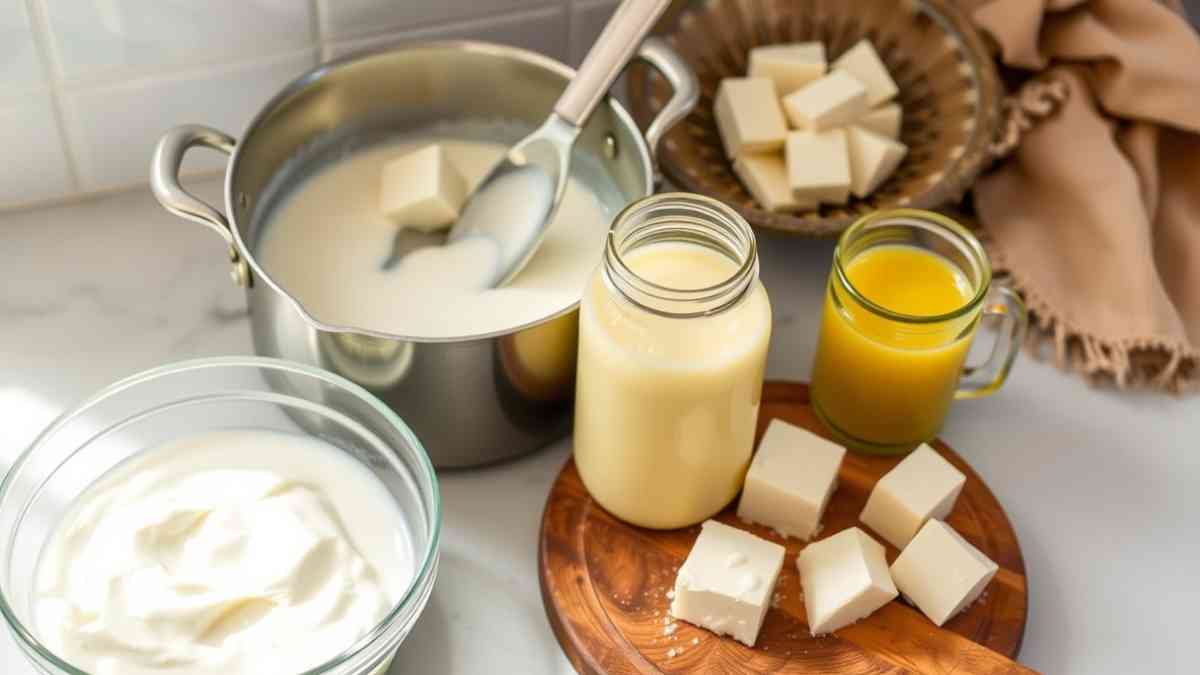Curds and Whey Food: Nutritional Benefits, Uses, and Everything You Should Know

Curds and whey food is a traditional dairy product formed by curdling milk, separating it into solid curds and liquid whey. Curds are rich in casein protein, calcium, and healthy fats, while whey contains fast-digesting proteins and essential vitamins. This nutrient-dense combination supports muscle growth, digestion, bone health, and immune function. Easily made at home using milk and an acidic agent like lemon juice, curds and whey can be used in various recipes, from cottage cheese and paneer to protein-rich smoothies and baked goods.
What Is Curds and Whey Food?
Curds and whey food refers to the two main components created when milk coagulates. This transformation happens either naturally or through the addition of enzymes or acids. The process splits milk into solid lumps known as curds and a watery liquid called whey. While the concept may sound old-fashioned to some, curds and whey have been a dietary staple across cultures for centuries.
Today, the term is best recognized from the nursery rhyme featuring Little Miss Muffet who “sat on a tuffet eating her curds and whey.” But beyond its literary presence, this food duo plays a significant role in both culinary and nutritional landscapes.
The Science Behind Curds and Whey
When milk is treated with an acid (like lemon juice or vinegar) or with the enzyme rennet, its proteins begin to separate. Casein proteins coagulate to form the curds, while whey proteins remain dissolved in the liquid part. This process is a foundational technique in cheese-making and forms the basis for many dairy products.
Curds are the soft, white clumps that result from this process. They contain casein, fats, calcium, and other nutrients.
Whey, on the other hand, is the thin liquid left behind. It contains water, lactose (milk sugar), vitamins, and high-quality whey proteins.
Nutritional Breakdown
Both curds and whey provide essential nutrients, though their profiles differ.
Curds:
- Rich in calcium and phosphorus
- High in casein protein
- Contains saturated fat and fat-soluble vitamins (A, D, E, and K)
- Provides a good amount of B vitamins
Whey:
- High in fast-digesting whey protein
- Low in fat
- Contains lactose and water-soluble vitamins (B1, B2, B6, B12)
- Known for its bioavailability, making it ideal for quick nutrient absorption
Together, curds and whey create a balanced source of protein, fat, and other essential nutrients, making them valuable in a balanced diet.
Health Benefits of Curds and Whey Food
Many nutritionists and health professionals advocate the inclusion of curds and whey food in regular diets due to its health benefits:
1. Muscle Growth and Recovery
Whey protein is one of the most effective supplements for muscle repair and growth. It contains all nine essential amino acids and is quickly absorbed by the body, making it perfect for post-workout nutrition.
2. Bone Health
Thanks to high calcium and phosphorus content, curds help strengthen bones and teeth. Regular consumption can contribute to preventing osteoporosis and other bone-related conditions.
3. Digestive Wellness
Curds contain probiotics when fermented properly, which promote gut health. These healthy bacteria improve digestion and strengthen the immune system.
4. Weight Management
Both curds and whey are satiating. They reduce hunger pangs and help control appetite, which can support weight loss or maintenance goals.
5. Immune Boosting Properties
Whey contains immunoglobulins and lactoferrin that help enhance immune function. This makes it a useful dietary component, especially during periods of illness or recovery.
6. Blood Pressure and Heart Health
Some studies have linked the peptides in whey with reduced blood pressure and improved cholesterol levels, suggesting cardiovascular benefits.
Culinary Uses of Curds and Whey
Curds and whey food is not just about health; it’s versatile in the kitchen too.
Curds Uses:
- Paneer: A popular Indian cheese made by pressing curds
- Cottage Cheese: Fresh curds seasoned or mixed with fruits
- Cheese Curds: A staple in Canadian poutine and other regional dishes
- Salads, Sandwiches, Wraps: Fresh curds add protein and texture
Whey Uses:
- Smoothies and Protein Shakes: Boosts protein content
- Baking: Can replace water or milk in breads and pancakes
- Fermentation: Great for soaking grains or fermenting vegetables
- Soups and Stews: Enhances flavor and nutritional value
How to Make Curds and Whey at Home
Creating curds and whey at home is easy and requires minimal ingredients. Here’s a basic method:
Ingredients:
- 1 liter of full-fat milk
- 2 tablespoons lemon juice or vinegar
Instructions:
- Heat the milk in a saucepan until it comes to a gentle boil.
- Turn off the heat and slowly add the acid while stirring.
- You’ll notice the milk starting to split into curds and whey.
- Let it sit for 10-15 minutes.
- Strain through a muslin cloth to separate curds from whey.
- Store the curds in the fridge and use the whey within 2-3 days.
This simple process opens up a world of homemade dairy products and nutritional additions to your meals.
Cultural Relevance and Historical Significance
Historically, curds and whey have been a central part of many diets across Asia, Europe, and the Middle East. In ancient times, they were valued for their shelf life, ease of preparation, and digestibility. Shepherds, farmers, and rural families across the world relied on this simple transformation to preserve milk.
In Ayurveda, the traditional Indian medical system, curds are considered to balance the digestive system when taken in moderation. Similarly, in ancient Greece and Rome, whey was known as “healing water” and was consumed by athletes.
Curds and Whey in Modern Diets
With growing interest in natural and whole foods, curds and whey food is experiencing a resurgence. More people are turning away from highly processed snacks and incorporating cottage cheese, Greek yogurt, paneer, and whey protein into their meals.
Athletes and fitness enthusiasts frequently use whey protein as a supplement, while home cooks and nutritionists embrace curds for their richness and simplicity.
Plant-based diets also mimic curds and whey in their own versions—using tofu (soy curds) and plant protein isolates as substitutes.
Common Myths and Facts
Myth: Whey is a waste product and should be thrown away.
Fact: Whey is rich in protein and vitamins; it’s beneficial in cooking and nutrition.
Myth: Only bodybuilders need whey protein.
Fact: Whey is valuable for all age groups and supports general wellness.
Myth: Curds are bad for people with lactose intolerance.
Fact: Many people with lactose sensitivity can tolerate curds because much of the lactose is fermented or drained out.
Tips for Incorporating Curds and Whey into Your Diet
- Mix whey into your morning oatmeal or smoothies.
- Use curds as a base for spreads and dips.
- Replace mayonnaise with seasoned cottage cheese for a lighter sandwich.
- Add curds to your wraps or stuffed parathas.
- Cook rice or pasta in diluted whey for added nutrition.
Conclusion
Curds and whey food is more than just a nursery rhyme reference; it’s a dynamic, nutritious, and versatile dietary component. Whether you’re looking to improve muscle mass, boost gut health, or simply add variety to your meals, this classic food offers time-tested benefits.
Easy to prepare, loaded with nutrients, and adaptable in recipes, curds and whey deserve a spot in every modern kitchen. As more people return to traditional food wisdom, these humble dairy elements are making a delicious comeback.



